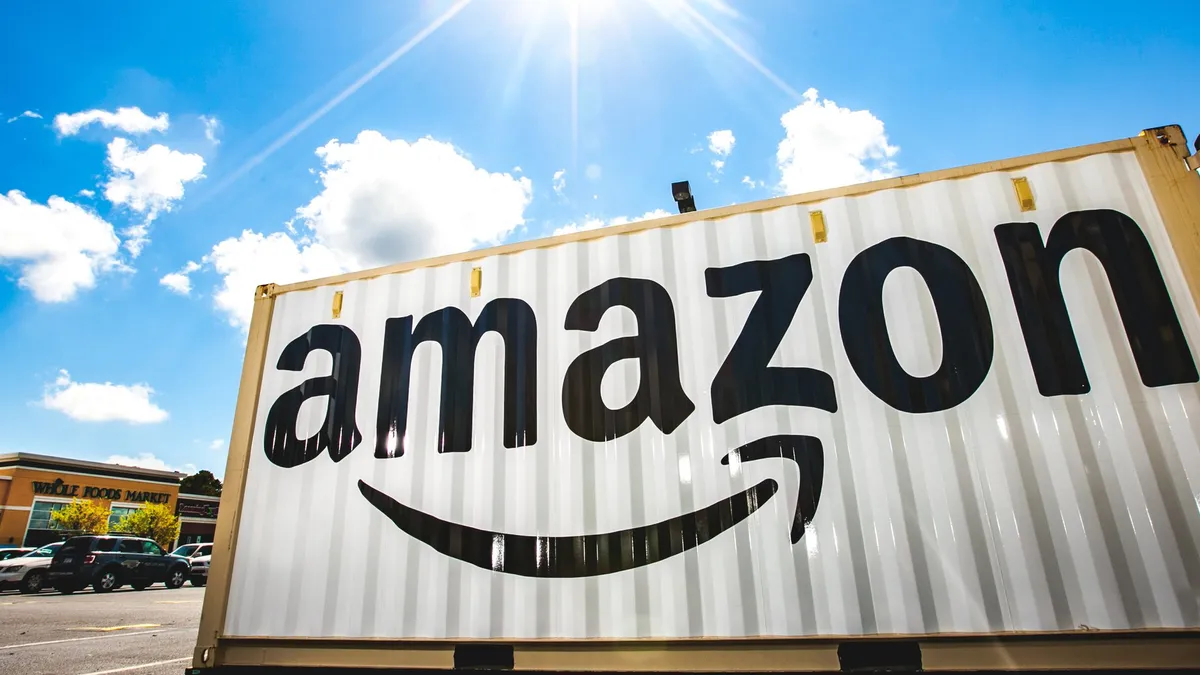Dive Brief:
- Amazon is preparing to open a new grocery chain with dozens of locations across the country, according to The Wall Street Journal, citing unnamed sources close to the company. The first location would open as early as the end of this year in Los Angeles. Amazon has also reportedly signed leases on at least two other locations slated to open early next year.
- The yet-to-be-named chain would be distinct from Whole Foods and carry a wider assortment of products, according to the WSJ report. The stores are planned to be around 35,000 square feet and could target strip malls as well as open-air shopping centers for expansion.
- Sources told WSJ that Amazon plans to acquire regional grocery chains with around 12 stores in order to accelerate the new chain's growth. Amazon is currently negotiating deals to open grocery stores in shopping centers located in a few major cities, including San Francisco, Seattle and Philadelphia.
Dive Insight:
Nearly two years after Amazon acquired Whole Foods for $13.7 billion, the supermarket brand the e-commerce company may establish could help it sell more groceries to more people, gather valuable data and continue feeding its Prime loyalty flywheel.
Since its marquee grocery acquisition, Amazon has pushed down prices at Whole Foods stores in an effort to net more customers. But refashioning a store commonly known as “Whole Paycheck,” at which analysts noted prices were typically 15% higher than the competition, has proven difficult. Although Prime members get some special savings and more conventional brands have appeared in the aisles, reports have noted little to no change in the retailer’s average basket prices. Last month, The Wall Street Journal reported that Whole Foods prices are actually starting to creep up as suppliers battle inflation and other headwinds.
Although its exact positioning is unclear at this point, Amazon’s new chain will presumably be more in line with a traditional supermarket. It may lean toward a value offering popularized by discounters like Aldi and Lidl, which would allow Whole Foods to maintain its positioning toward the high end of the market, and the new brand would reach a more mainstream audience.
“If I'm Amazon, I'm thinking of opening a store more conventionally driven, more price-oriented than Whole Foods,” said Neil Stern, senior partner with McMillanDoolittle, in an interview with sister publication Grocery Dive following Friday’s news.
Amazon acquired Whole Foods after struggling to grow its online food and beverage business, including its AmazonFresh brand. News of the new chain further proves that the e-commerce powerhouse needs physical stores in order to succeed in grocery, sources said.
“Grocery is still a store-based business. Amazon didn't upend the grocery industry with Whole Foods, so now it's taking matters into its own hands,” Matt Lindner, senior e-commerce analyst with Mintel, told Grocery Dive.
Amazon would use its new stores as distribution points for its growing grocery e-commerce business, WSJ reports. Same-day delivery through Whole Foods has reached more than 60 markets while store pickup touches more than 20. Both services offer an option for Prime members that waives the fulfillment fee — a move that addresses the price sensitivity many shoppers have toward online grocery shopping.
In addition to delivery from the unnamed new chain and from Whole Foods stores, Amazon’s physical footprint would allow it to build out AmazonFresh — which exited several markets back in in 2017 — and generally get food and beverage orders to shoppers faster and cheaper than before. Earlier this week, Amazon’s Happy Belly private label launched its first milk and dairy products, available only through AmazonFresh.
Perhaps most importantly, a conventional supermarket chain would offer yet another avenue for Amazon to collect consumer data and learn how to sell more cereal, produce, meat and other groceries to consumers. The company’s ability to adapt and learn — not to mention its $850 billion market cap — puts it in a class all by itself in the supermarket industry.
“Amazon grocery stores will certainly use their expansive shopper data to merge the in-store and online grocery experience,” Sylvain Perrier, CEO with grocery e-commerce provider Mercatus, wrote in comments emailed to Grocery Dive.
One big question mark in all of this is how Amazon would integrate its bleeding-edge technology into new stores. Whole Foods locations won’t see its cashier-free Amazon Go technology, company officials have said, but a new chain’s stores, at just 35,000 square feet, could seem ideally suited.
For conventional grocers like Kroger and Albertsons, which haven’t yet seen their bottom lines impacted by the Whole Foods buy, this news signals a new competitive challenge. These chains have accelerated their rollout of store technology and online shopping, straining their profitability as they struggle to insulate their businesses.
A new grocery chain from the world’s largest e-commerce company could signal an even faster rollout of online and in-store innovation. If Amazon brings the same low-price strategy it employs online to the new stores, it could also mean even more heated price wars in crowded markets across the U.S.
"Amazon has that brand recognition and association in the mind of the consumer that if you shop online, you're going to get the lowest price anywhere,” Lindner said. “If Amazon can bring that low price model to grocery chains, especially where the profit margin is so low, then it could be a game changer."

















